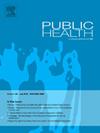体力活动悖论与衰老:一项基于人群的特定领域体力活动与生物衰老关系的研究
IF 3.2
3区 医学
Q1 PUBLIC, ENVIRONMENTAL & OCCUPATIONAL HEALTH
引用次数: 0
摘要
目的最近的证据表明,休闲时间的身体活动(LTPA)是有益的,而对于那些高职业身体活动(OPA)水平的人来说,它可能是有害的。我们的目的是研究特异性PA与整个身体和器官(心脏、肾脏和肝脏)年龄的关系。研究设计分析使用了NHANES的数据,这是一项有14168名登记成人参与者的横断面研究。方法采用全球身体活动问卷(GPAQ)对特定领域的PA(即休闲、交通和职业)进行评估。生物年龄由循环生物标志物计算。为了量化参与者之间的生理年龄差异,评估了生物年龄加速(BAA)。采用线性回归分析评估域特异性PA与全身及器官(心、肾、肝)BAA的相关性。结果多元线性模型显示,总PA与全身BAA呈负相关(β - 0.47, 95% CI(- 0.71, - 0.22))。此外,LTPA与全身BAA (β - 0.41, 95% CI(- 0.60, - 0.21))和肝脏BBA (β - 1.20, 95% CI(- 2.05, - 0.35))呈负相关。然而,OPA与心脏BAA呈正相关(β 1.69, 95% CI(1.05, 2.33)),我们发现只有OPA≥300分钟/周的参与者与心脏BAA呈正相关(β 1.97, 95% CI(1.27, 2.66))。结论sltpa与全身和活BAA减慢有关,而高OPA与心脏BAA升高有关。特定领域的身体活动与生物衰老之间的关联可能因活动领域而异。本文章由计算机程序翻译,如有差异,请以英文原文为准。
Physical activity paradox and aging: A population-based study on the association of domain-specific physical activity with biological aging
Objectives
A physical activity paradox is suggested by recent evidence that leisure-time physical activity (LTPA) is beneficial, whereas it may be detrimental to those with high occupational physical activity (OPA) levels. We aimed to investigate the association of domain-specific PA on the age of the whole body and organs (heart, kidneys, and liver).
Study design
The analysis utilized data from NHANES, a cross-sectional study with 14,168 enrolled adult participants.
Methods
Domain-specific PA (i.e., Leisure, Transportation, and Occupation) was assessed using the Global Physical Activity Questionnaire (GPAQ). Biological age was calculated from circulating biomarkers. To quantify differences in physiological age between participants, biological age acceleration (BAA) was assessed. Linear regression analysis was used to assess the association of domain-specific PA with BAA of the whole body and organs (heart, kidney, and liver).
Results
The multivariate linear model showed that total PA was negatively associated with whole-body BAA (β −0.47, 95 % CI (−0.71, −0.22)). In addition, LTPA was negatively associated with whole-body BAA (β −0.41, 95 % CI (−0.60, −0.21)) and liver BBA (β −1.20, 95 % CI (−2.05, −0.35)). Whereas OPA was positively associated with heart BAA (β 1.69, 95 % CI (1.05, 2.33)), and we found that only participants who performed OPA≥300 min/week were positively associated with heart BAA (β 1.97, 95 % CI (1.27, 2.66)).
Conclusions
LTPA was associated with slower whole-body and live BAA, while high OPA is associated with higher heart BAA. Associations between domain-specific physical activity and biological aging may differ across activity domains.
求助全文
通过发布文献求助,成功后即可免费获取论文全文。
去求助
来源期刊

Public Health
医学-公共卫生、环境卫生与职业卫生
CiteScore
7.60
自引率
0.00%
发文量
280
审稿时长
37 days
期刊介绍:
Public Health is an international, multidisciplinary peer-reviewed journal. It publishes original papers, reviews and short reports on all aspects of the science, philosophy, and practice of public health.
 求助内容:
求助内容: 应助结果提醒方式:
应助结果提醒方式:


